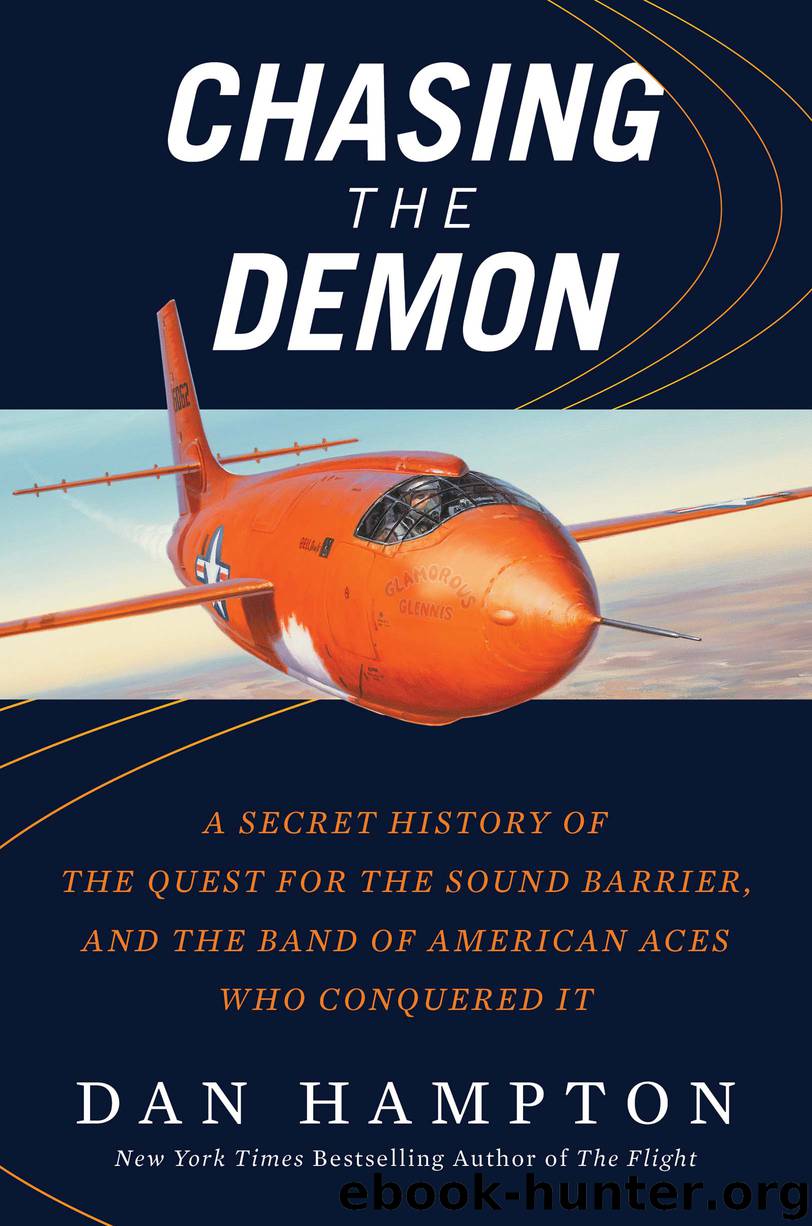Chasing the Demon by Dan Hampton

Author:Dan Hampton
Language: eng
Format: epub
Publisher: HarperCollins
Published: 2018-06-18T16:00:00+00:00
Nineteen forty-six, then, dawned with hope and promise. “It was a banner year,” Ken Chilstrom remembers fondly. “It was actually the best year for me as a pilot!” Two days after the X-1 glide flight, Colonel Bill Councill lifted off from Daughtery Field in Long Beach, California, turned east, and streaked 2,457 miles across the United States in a Lockheed P-80A-1 Shooting Star. Maintaining an average speed of 584 miles per hour, he made it nonstop to New York’s La Guardia Field in four hours, thirteen minutes, and twenty-six seconds, thus setting a new Fédération Aéronautique Internationale record.* Councill’s feat was significant for several reasons; first, it demonstrated the jet’s capability to safely cross great distances at high speed, and this was not lost on military planners from either side of the Atlantic. Second, the flight fired the imagination of a war-weary public and gave a very clear, exciting look into the future of aviation.
With the most recent war won, the U.S. government and military leadership now seemed determined to never be caught unawares as they had been in 1941 so, to that end, development and testing of new aircraft would include as many combat veterans as possible. Men who had seen what works and what did not, who knew what was important beyond the drawing boards and the boardrooms. Consequently, Fighter Test at Wright Field was now home to many legendary Air Corps pilots from the war. Men like Richard Bong, Don Gentile, “Gabby” Gabreski, and Gus Lundquist. Also pilots like Ken Chilstrom and Glen Edwards who had fought the close-air-support side of the war, and younger pilots like Bob Hoover or Chuck Yeager, who were eager to fly anything they could get their hands on.
Through the spring of 1946, Bell worked out the X-1’s bugs and Chilstrom’s boss, Colonel Al Boyd, picked him for a special mission that, quite pleasingly, closed a loop in aviation history. On the surface, it seemed an annoyance but Ken, who admired Al Boyd like no other man, would have done anything asked by the chief of Flight Test. On June 22, 1946, just three years after he flew a piston-engined fighter into combat over Pantelleria, Ken piloted a Shooting Star jet fighter up to Schenectady, New York, and picked up a letter from General Electric’s corporate office. GE, of course, had been granted the initial U.S. license to manufacture Frank Whittle’s W.1 engine during the war and continued its progress with the I-16 and I-40 jets. Ken’s P-80 was powered by a J33-GE-11 jet engine, and the letter was one of thanks that the Air Corps wanted hand delivered: to none other than Orville Wright, and at the very field that bore his name.
“I landed at Wright and taxied slowly up to the base of the tower,” Chilstrom reflected nostalgically. “There was a black sedan there, all alone. I shut the jet down, climbed down, and pulled the letter out of my chest pocket. It was a little sweaty.” He chuckled. “Anyway, I walked over to the car, and the back window rolled down and there he was—Orville Wright.
Download
This site does not store any files on its server. We only index and link to content provided by other sites. Please contact the content providers to delete copyright contents if any and email us, we'll remove relevant links or contents immediately.
| Automotive | Engineering |
| Transportation |
Small Unmanned Fixed-wing Aircraft Design by Andrew J. Keane Andras Sobester James P. Scanlan & András Sóbester & James P. Scanlan(32759)
Navigation and Map Reading by K Andrew(5126)
Endurance: Shackleton's Incredible Voyage by Alfred Lansing(4712)
And the Band Played On by Randy Shilts(2159)
The Box by Marc Levinson(1957)
Top 10 Prague (EYEWITNESS TOP 10 TRAVEL GUIDES) by DK(1951)
Wild Ride by Adam Lashinsky(1949)
The Race for Hitler's X-Planes: Britain's 1945 Mission to Capture Secret Luftwaffe Technology by John Christopher(1834)
The One Percenter Encyclopedia by Bill Hayes(1807)
Trans-Siberian Railway by Lonely Planet(1724)
Girls Auto Clinic Glove Box Guide by Patrice Banks(1701)
Bligh by Rob Mundle(1673)
Looking for a Ship by John McPhee(1647)
Good with Words by Patrick Barry(1634)
Batavia's Graveyard by Mike Dash(1626)
TWA 800 by Jack Cashill(1620)
Fighting Hitler's Jets: The Extraordinary Story of the American Airmen Who Beat the Luftwaffe and Defeated Nazi Germany by Robert F. Dorr(1608)
Troubleshooting and Repair of Diesel Engines by Paul Dempsey(1575)
Ticket to Ride by Tom Chesshyre(1563)
